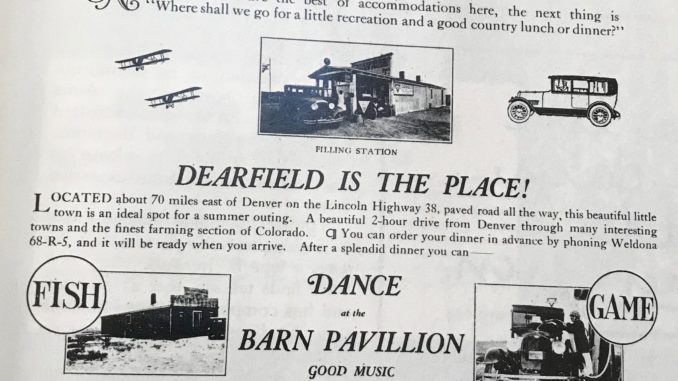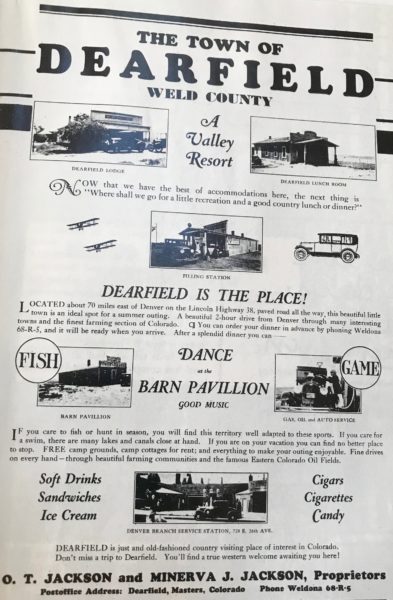
by Libby James
Judd, Pierce, Midway, Roggen, Grover, New Raymer, Keota, Hereford, Dearfield: These little towns dot the map of eastern Colorado. To someone not familiar with the state, it might seem like the area is bustling with activity. But the truth is, many of these spots on the dry, high plains are scarcely more than crumbling reminders of what they once were.
Yet with only a little imagination, it’s possible to envision them during the days when a steady stream of settlers came west in hopes of finding rich agricultural land. “Rain follows the plow,” was an oft-heard pronouncement, and for a few years at the beginning of the twentieth century, that appeared to be true.
But when hard economic times hit and the high plains reverted to the desert that is the true nature of the land, many of the settlers in these places moved on, leaving their hopes and dreams to shrivel in the wind.
Colorado mountain ghost towns hold a romantic fascination for visitors, to the neglect of the ghost towns of the plains. Within a short drive from Fort Collins or Greeley there are enough ghost and nearly ghost towns worth exploring to fill every summer weekend.

The remains of Dearfield, on Highway 34, about 25 miles east of Greeley, have an especially fascinating past. There’s not a whole lot to see anymore in this, the only town in Colorado ever incorporated as a black community, but its name and its story are an example of determination, hope and despair.
From its establishment in 1910 until the onset of a declining market for farm produce and the Dust Bowl devastation of the 1930s, Dearfield represented freedom, independence and a chance to get ahead in a white world.
Here’s how the Weld County News described the town in 1921:
“…[T]he colony has grown until there are nearly 700 people there, all independent and earning a living and more. The lands were worth practically nothing when the colony was established and are now worth, in the aggregate, probably $750,000 with the improvements which the colored farmers have added. Their livestock and poultry are valued at not less than $200,000 and their annual production is in the neighborhood of $125,000. There are, within the limits of the colony, a school and two churches…. The Dearfield farmers and their families are happy today. They have won handsomely where nothing but failure was predicted for them. The colony and the success of its people are the fruition of the plans of O.T. Jackson and his wife (Minerva). To them, Dearfield is a dream that came true.”
Other reports suggest that the town also had a boarding house, restaurant and grocery store in 1920. But by 1940, the population had dwindled to 12 and dreams of prosperity had faded except for founder Oliver Toussaint Jackson who continued to believe that better times were ahead and lived in Dearfield until his death.
Jackson was born in Oxford, Ohio, in 1862, made his way to Boulder in 1887, and worked as a caterer, restaurant manager, and for several years as a farmer. Inspired by the writings of Booker T. Washington and by the need he saw for blacks to become self-sufficient, he began to envision a place where his people could farm, govern themselves and reap the benefits of their efforts. To that end, he became involved in Colorado politics and eventually was appointed as messenger to Governor John Shafroth, a position that made it possible for him to actively pursue his dream. With the governor’s assistance and blessing, he staked a desert claim for 320 acres 25 miles east of Greeley on Highway 34 in 1910.
By the following spring, Jackson, his wife, Minerva, his father-in-law and a boy they had taken in to raise had built a home on the land. Of the seven families who joined them, only two had time to build frame homes before winter set in. They made do with tents, dugouts or caves built into the hillside. Buffalo chips and sagebrush were their only fuel, except for an occasional piece of wood that had to be carried several miles from the Platte River. But the homesteaders persisted. They learned the techniques of dryland farming, built themselves permanent homes and began to prosper.
In 1921, Jackson mailed a pamphlet inviting blacks across the country to come to Dearfield. It said: “The town of Dearfield has laid a solid foundation for the building of the wealthiest settlement of Colored People in the United States.” He went on to list opportunities for a doctor, blacksmith, trucking line and bank. He planned a 50-room tourist hotel, a canning factory and a soap factory. He hoped for a population of 2,000 by 1924.
But it was not to be. As homesteaders deserted the windblown land, he and Minerva hung on, operating a gas station on the highway. Minerva died in 1942, and the following year, Jackson’s niece, Jenny Jackson, came from Chicago to care for her ailing uncle. She hauled wood, coal and water and listened to her uncle reflect on the future of Dearfield. Through him she became convinced that salvation for blacks in America lay in education and a return to the land. She came to believe that one day blacks would return and Dearfield would prosper again. When Jackson died in 1948, Jenny stayed in the house her uncle left to her, hoping that oil exploration in the area might bring new life to the town. The Denver Post’s Empire Magazine described Jenny as “the Baby Doe of the drylands.”
Perhaps she was. Perhaps it was her conviction that Dearfield would prosper once again that kept her there until her death in 1974.
Thanks to Hazel Johnson of Greeley, whose files provided information for this story and also the Dearfield poster.
Support Northern Colorado Journalism
Show your support for North Forty News by helping us produce more content. It's a kind and simple gesture that will help us continue to bring more content to you.
BONUS - Donors get a link in their receipt to sign up for our once-per-week instant text messaging alert. Get your e-copy of North Forty News the moment it is released!
Click to Donate
